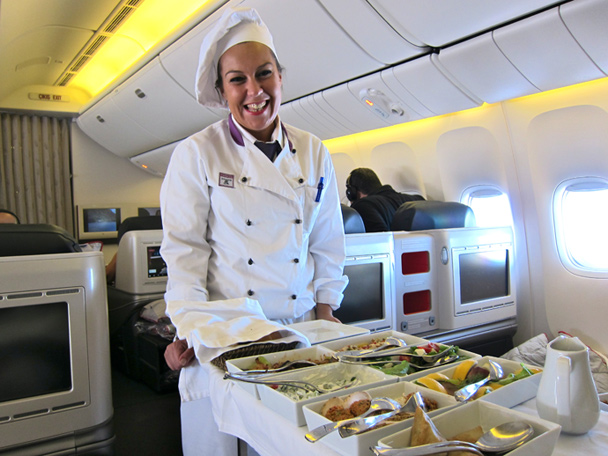It’s 2050. You’re on Global Airways’ three-hour flight from Los Angeles to Singapore and you’re famished. Does a robot present your dinner pill on command, or are harried flight attendants still asking “chicken or beef” and dropping rubbery entrées onto tired trays?
Futurists and culinary visionaries have wildly varying, mind-boggling theories on how airline meals will look decades forward, but the experts I spoke to agreed on one thing: We’re not going to merely swallow a pill in the sky and call it supper. Because what would be the fun in that?
No matter how much our lives change, we will still want to eat for pleasure. Eating also helps pass time—key for even short flights, which most will be, according to futurists like Patrick Tucker, deputy editor of The Futurist magazine and director of communications for the World Future Society, and Faith Popcorn, founder of Faith Popcorn’s BrainReserve, a marketing consulting firm, and author of The Popcorn Report.
Popcorn believes that while we will have alternatives to traditional meals for nourishment, we will still be able to choose to eat regular food—even on airplanes. And flyers will have limitless culinary choices.
“One of the most fascinating technologies out right now is 3-D printing,” Popcorn says. “These printers can turn out anything—chairs, even human organs. By 2050 we will have food printers that can put together any dish by printing the ingredients. Passengers can request literally anything in the world, and have it printed up for their airline snack.”
Popcorn also predicts that food with functional ingredients will be commonplace. “Imagine how great it would be to get on a plane and have an Ambien Sandwich,” says Popcorn. “Delicious and coma-inducing.”
Nathan Myhrvold, coauthor of the groundbreaking Modernist Cuisine: The Art and Science of Cooking, a six-volume $600 tome on molecular cuisine, says that a typical 2050 airline menu will include traditional food styles plus ones we’ve yet to invent. “There will also be ‘retro’ food much like today—or even ages past,” predicts Myhrvold. Ages past. Might we be swiping an airline touch screen menu offering updates on Elizabethan favorites like baked swan with mead, perhaps?
World Future Society’s Patrick Tucker envisions more vegetarian options for in-sky dining, just like on terra firma. “From an ethical, economical, and environmental point of view, lentils and such are better airplane options,” he says.
Unless we eat meat grown in test tubes. “I think there will be test-tube meat on airplanes in 2050,” says Josh Schonwald, author of the forthcoming Taste of Tomorrow: Dispatches From the Future of Food. “By then we’ll reach a point where lab-grown meat has the taste and mouth feel of ‘real’ meat.”
And will tomorrow’s airplane kitchens resemble today’s? Tucker says to expect more cooking onboard and possibly ingredient growing, too. “But space will still be a premium, so look for fresher ingredients and dishes that don’t require elaborate preparation,” he adds.
Schonwald predicts galleys might become a distant memory, although food quality will be vastly improved. “Planes could be totally stripped of heating devices [for food] by 2050,” he says. “For a glimpse of the future, look to the United States military, who has often been ahead of the curve on food innovation,” says Schonwald. “The army is already using ingenious flameless ration heaters (water-activated, exothermic chemical heaters). In 2050 we’ll be eating a lab-spawned, kill-free chicken sandwich heated without using a microwave or oven.”
Where we eat is also up for grabs. Myhrvold envisions passengers eating in their seats for space efficiency. Popcorn sees future aircraft as either streamlined completely for the fastest trip possible (which points to in-seat snacks), or more like ocean liners, designed to provide luxury experiences.
“Aviation improvements will make turbulence a thing of the past, making it possible for planes to house five-star restaurants complete with kitchen, staff, dining area, and cocktail lounge,” says Popcorn. “Some planes will have kitchens that could feed thousands, while others will have no need for such an archaic form of food preparation.”
She also sees some aircraft designed so passengers can cook their own meals. “Food on airplanes will be considered part of the adventure of flying,” says Popcorn. “Airlines will need some way to get people to fly once we’ve invented teleportation.”
If you’re not paying premium fares, however, you could be munching standing up; future economy seats may no longer be, well, seats. Tucker explains: “According to some estimates, biofuel-powered hypersonic jets will shuttle passengers from London to Tokyo in less than two and a half hours by 2050. More companies may be able to offer strapped-in-only ‘seating.’”
Tucker also doubts today’s flight attendant will be serving tomorrow’s meals. That’s right, he’s talking robots. We might get a robot’s attention via a voice command, simple gesture, or perhaps, just being. “Ideally, the craft itself would read the biometric signaling of passengers and predict their hunger levels,” says Tucker.
Trendsetting Wylie Dufresne, chef and co-owner of New York’s modern-American mecca wd-50, takes a less Trekky approach to future in-flight meals. “Rather than making things more complicated and futuristic, it might be better to make food more basic but of higher quality,” Dufresne says. “I think people would be happy with less, if done properly. A good sandwich and a well-made cup of hot soup would be great.”



 Pinterest
Pinterest


